Electrochemical Sensor for Determination of Various Phenolic Compounds in Wine Samples Using Fe3O4 Nanoparticles Modified Carbon Paste Electrode
Abstract
1. Introduction
2. Materials and Methods
2.1. Chemicals and Reagents
2.2. Instrumentation and Methods
2.3. Fabrication of Bare CPE and MCPE
2.4. Voltammetric Measurements
2.5. Preparation and Detection Procedure of Real Samples (Red and White Wine)
3. Results and Discussion
3.1. Electrochemical Behavior of the Phenolic Compounds at CPE and MCPE
3.2. Evaluation of the Electroactive Surface Area
3.3. Effect of pH on the Phenolic Compounds Oxidation at CPE and MCPE
3.4. Effect of Scan Rate on the Phenolic Compounds Oxidation at CPE and MCPE
3.5. Characterization of CPE and MCPE Using EIS
3.6. Application of Gold Screen-Printed Electrode for Rapid Validation Test of Phenolic Compounds Using Cyclic Voltammetry
3.7. Effect of Concentration on the Phenolic Compounds Oxidation at CPE and MCPE
3.8. Reproducibility, Repeatability, and Stability
3.9. Selectivity of the Electrode
3.10. Simultaneous Detection of the Phenolic Compounds at MCPE
3.11. Application of CPE and MCPE on Phenolic Compounds Detection in Red and White Wines
4. Conclusions
Supplementary Materials
Author Contributions
Funding
Conflicts of Interest
References
- Ramirez-Lopez, L.M.; McGlynn, W.; Goad, C.L.; DeWitt, C.A.M. Simultaneous determination of phenolic compounds in Cynthiana grape (Vitis aestivalis) by high-performance liquid chromatography-electrospray ionization-mass spectrometry. Food Chem. 2014, 149, 15–24. [Google Scholar] [CrossRef]
- Fukuji, T.S.; Tonin, F.G.; Tavares, M.F.M. Optimization of a method for determination of phenolic acids in exotic fruits by capillary electrophoresis. J. Pharm. Biomed. Anal. 2010, 51, 430–438. [Google Scholar] [CrossRef]
- Gutiérrez-Grijalva, E.P.; Picos-Salas, M.A.; Leyva-López, N.; Criollo-Mendoza, M.S.; Vazquez-Olivo, G.; Heredia, J.B. Flavonoids and phenolic acids from Oregano: Occurrence, biological activity and health benefits. Plants 2018, 7, 2. [Google Scholar] [CrossRef]
- Robbins, R.J. Phenolic acids in foods: An overview of analytical methodology. J. Agric. Food Chem. 2003, 51, 2866–2887. [Google Scholar] [CrossRef]
- Gabriella, S.; Veronica, A.; Virginia, C.; Leontin, D.; Zaharie, M. Determination of phenolic compounds from wine samples by GC/MS system. Rev. Chim. 2012, 63, 855–858. [Google Scholar]
- Tian, R.R.; Pan, Q.H.; Zhan, J.C.; Li, J.M.; Wan, S.B.; Zhang, Q.H.; Huang, W.D. Comparison of phenolic acids and flavan-3-ols during wine fermentation of grapes with different harvest times. Molecules 2009, 14, 827–838. [Google Scholar] [CrossRef] [PubMed]
- Dobes, J.; Zitka, O.; Sochor, J.; Ruttkay-Nedecky, B.; Babula, P.; Beklova, M.; Kynicky, J.; Hubalek, J.; Klejdus, B.; Kizek, R.; et al. Electrochemical tools for determination of phenolic compounds in plants. A review. Int. J. Electrochem. Sci. 2013, 8, 4520–4542. [Google Scholar]
- Tomac, I.; Šeruga, M.; Labuda, J. Evaluation of antioxidant activity of chlorogenic acids and coffee extracts by an electrochemical DNA-based biosensor. Food Chem. 2020, 325, 126787. [Google Scholar] [CrossRef]
- Chiorcea-Paquim, A.M.; Enache, T.A.; De Souza Gil, E.; Oliveira-Brett, A.M. Natural phenolic antioxidants electrochemistry: Towards a new food science methodology. Compr. Rev. Food Sci. Food Saf. 2020, 19, 1680–1726. [Google Scholar] [CrossRef]
- Da Silva, D.M.; da Cunha Areias, M.C. Rutin as an Electrochemical Mediator in the Determination of Captopril using a Graphite Paste Electrode. Electroanalysis 2020, 32, 301–307. [Google Scholar] [CrossRef]
- Sheng, K.; Zhang, Q.; Li, L.; Wang, Y.L.; Ye, B. A new voltammetric sensor and its application in pharmaceutical analysis for rutin. J. Environ. Sci. Health Part A 2020, 1–10. [Google Scholar] [CrossRef] [PubMed]
- D’Souza, O.J.; Mascarenhas, R.J.; Satpati, A.K.; Basavaraja, B.M. A novel ZnO/reduced graphene oxide and Prussian blue modified carbon paste electrode for the sensitive determination of Rutin. Sci. China Chem. 2019, 62, 262–270. [Google Scholar] [CrossRef]
- Karabiberoğlu, Ş.U.; Dursun, Z. Fabrication of nickel coated graphene oxide composite electrode for sensitive determination of Rutin. J. Electroanal. Chem. 2018, 815, 76–85. [Google Scholar] [CrossRef]
- Apetrei, I.M.; Apetrei, C. A modified nanostructured graphene-gold nanoparticle carbon screen-printed electrode for the sensitive voltammetric detection of rutin. Meas. J. Int. Meas. Confed. 2018, 114, 37–43. [Google Scholar] [CrossRef]
- Yan, L.; Niu, X.; Wang, W.; Li, X.; Sun, X.; Zheng, C.; Wang, J.; Sun, W. Electrochemical sensor for rutin detection with graphene oxide and multi-walled carbon nanotube nanocomposite modified electrode. Int. J. Electrochem. Sci. 2016, 11, 1738–1750. [Google Scholar]
- Sousa, W.R.; da Rocha, C.; Cardoso, C.L.; Silva, D.H.S.; Zanoni, M.V.B. Determination of the relative contribution of phenolic antioxidants in orange juice by voltammetric methods. J. Food Compos. Anal. 2004, 17, 619–633. [Google Scholar] [CrossRef]
- Janeiro, P.; Novak, I.; Seruga, M.; Oliveira-Brett, A.M. Electroanalytical oxidation of p-coumaric acid. Anal. Lett. 2007, 40, 3309–3321. [Google Scholar] [CrossRef]
- Yıldırım, S.; Kadıoğlu, A.; Sağlam, A.; Yaşar, A. Determination of phenolic acids and rutin in Heliotropium thermophilum by high-performance liquid chromatography with photodiode array detection. Instrum. Sci. Technol. 2017, 45, 35–48. [Google Scholar] [CrossRef]
- Cao, Y.H.; Wang, Y.; Yuan, Q. Analysis of Flavonoids and Phenolic Acid in Propolis by Capillary Electrophoresis. Chromatographia 2004, 59, 135–140. [Google Scholar] [CrossRef]
- David, I.G.; Buleandră, M.; Popa, D.E.; Bîzgan, A.M.C.; Moldovan, Z.; Badea, I.A.; Iorgulescu, E.E.; Tekiner, T.A.; Basaga, H. Voltammetric determination of polyphenolic content as rosmarinic acid equivalent in tea samples using pencil graphite electrodes. J. Food Sci. Technol. 2016, 53, 2589–2596. [Google Scholar] [CrossRef]
- Tashkhourian, J.; Nami-Ana, S.F. A sensitive electrochemical sensor for determination of gallic acid based on SiO2 nanoparticle modified carbon paste electrode. Mater. Sci. Eng. C 2015, 52, 103–110. [Google Scholar] [CrossRef]
- Arduini, F.; Di Giorgio, F.; Amine, A.; Cataldo, F.; Moscone, D.; Palleschi, G. Electroanalytical characterization of carbon black nanomaterial paste electrode: Development of highly sensitive tyrosinase biosensor for catechol detection. Anal. Lett. 2010, 43, 1688–1702. [Google Scholar] [CrossRef]
- Chikere, C.O.; Faisal, N.H.; Kong-Thoo-Lin, P.; Fernandez, C. Interaction between amorphous zirconia nanoparticles and graphite: Electrochemical applications for gallic acid sensing using carbon paste electrodes in wine. Nanomaterials 2020, 10, 537. [Google Scholar] [CrossRef]
- Tashkhourian, J.; Ana, S.F.N.; Hashemnia, S.; Hormozi-Nezhad, M.R. Construction of a modified carbon paste electrode based on TiO2 nanoparticles for the determination of gallic acid. J. Solid State Electrochem. 2013, 17, 157–165. [Google Scholar] [CrossRef]
- Abdi, R.; Ghorbani-HasanSaraei, A.; Karimi-Maleh, H.; Raeisi, S.N.; Karimi, F. Determining caffeic acid in food samples using a voltammetric sensor amplified by Fe3O4 nanoparticles and room temperature ionic liquid. Int. J. Electrochem. Sci. 2020, 15, 2539–2548. [Google Scholar] [CrossRef]
- Sanchayanukun, P.; Muncharoen, S. Chitosan coated magnetite nanoparticle as a working electrode for determination of Cr(VI) using square wave adsorptive cathodic stripping voltammetry. Talanta 2020, 217, 121027. [Google Scholar] [CrossRef]
- Xu, J.K.; Zhang, F.F.; Sun, J.J.; Sheng, J.; Wang, F.; Sun, M. Bio and nanomaterials based on Fe3O4. Molecules 2014, 19, 21506–21528. [Google Scholar] [CrossRef]
- Luo, J.H.; Li, B.L.; Li, N.B.; Luo, H.Q. Sensitive detection of gallic acid based on polyethyleneimine-functionalized graphene modified glassy carbon electrode. Sens. Actuators B Chem. 2013, 186, 84–89. [Google Scholar] [CrossRef]
- Abdel-Hamid, R.; Newair, E.F. Electrochemical behavior of antioxidants: I. Mechanistic study on electrochemical oxidation of gallic acid in aqueous solutions at glassy-carbon electrode. J. Electroanal. Chem. 2011, 657, 107–112. [Google Scholar] [CrossRef]
- Zare, H.R.; Golabi, S. Electrocatalytic oxidation of reduced nicotinamide adenine dinucleotide (NADH) at a chlorogenic acid modified glassy carbon electrode. J. Electroanal. Chem. 1999, 464, 14–23. [Google Scholar] [CrossRef]
- Golabi, S.M.; Zare, H.R. Electrocatalytic oxidation of hydrazine at glassy carbon electrode modified with electrodeposited film derived from caffeic acid. Electroanalysis 1999, 11, 1293–1300. [Google Scholar] [CrossRef]
- Souza, L.P.; Calegari, F.; Zarbin, A.J.G.; Marcolino-Júnior, L.H.; Bergamini, M.F. Voltammetric determination of the antioxidant capacity in wine samples using a carbon nanotube modified electrode. J. Agric. Food Chem. 2011, 59, 7620–7625. [Google Scholar] [CrossRef] [PubMed]
- Mirceski, V.; Gulaboski, R.; Lovric, M.; Bogeski, I.; Kappl, R.; Hoth, M. Square-wave voltammetry: A review on the recent progress. Electroanalysis 2013, 25, 2411–2422. [Google Scholar] [CrossRef]
- Lund, H.; Hammerich, O. (Eds.) Organic Electrochemistry; Harper and Row: New York, NY, USA, 1972. [Google Scholar]
- Monnappa, A.B.; Manjunatha, J.G.; Bhatt, A.S. Design of a sensitive and selective voltammetric sensor based on a cationic surfactant-modified carbon paste electrode for the determination of alloxan. ACS Omega 2020, 5, 23481–23490. [Google Scholar] [CrossRef]
- Compton, R.; Banks, C. Understanding Voltammetry, 2nd ed.; Imperial College Press: London, UK, 2010. [Google Scholar]
- Ferreira, V.; Tenreiro, A.; Abrantes, L.M. Electrochemical, microgravimetric and AFM studies of polythionine films: Application as new support for the immobilization of nucleotides. Sens. Actuators B Chem. 2006, 119, 632–641. [Google Scholar] [CrossRef]
- Giacomelli, C.; Ckless, K.; Galato, D.; Miranda, F.S.; Spinelli, A. Electrochemistry of caffeic acid aqueous solutions with pH 2.0 to 8.5. J. Braz. Chem. Soc. 2002, 13, 332–338. [Google Scholar] [CrossRef]
- Pletcher, D.; Greff, R.; Peat, R.; Peter, L.M.; Robinson, J. Instrumental Methods in Electrochemistry; Woodhead Publishing Ltd.: Cambridge, UK, 1985. [Google Scholar]
- Chrzescijanska, E.; Wudarska, E.; Kusmierek, E.; Rynkowski, J. Study of acetylsalicylic acid electroreduction behavior at platinum electrode. J. Electroanal. Chem. 2014, 713, 17–21. [Google Scholar] [CrossRef]
- Kissinger, P.; Heineman, W.R. (Eds.) Laboratory Techniques in Electroanalytical Chemistry, 2nd ed.; Marcel Dekker: New York, NY, USA, 1996. [Google Scholar]
- Timbola, A.K.; Souza, C.D.; Soldi, C.; Pizzolatti, M.G.; Spinelli, A. Electro-oxidation of rutin in the presence of p-toluenesulfinic acid. J. Appl. Electrochem. 2007, 37, 617–624. [Google Scholar] [CrossRef]
- Madhusudhana; Manasa, G.; Bhakta, A.K.; Mekhalif, Z.; Mascarenhas, R.J. Bismuth-nanoparticles decorated multi-wall-carbon-nanotubes cast-coated on carbon paste electrode; an electrochemical sensor for sensitive determination of Gallic Acid at neutral pH. Mater. Sci. Energy Technol. 2020, 3, 174–182. [Google Scholar] [CrossRef]
- Parliament, E. Regulation (EC) No 1333/2008 of the European Parliament and of the Council of 16 December 2008 on Food Additives; Euratom: Rome, Italy, 2004. [Google Scholar]
- Kumar, A.; Purohit, B.; Mahato, K.; Roy, S.; Srivastava, A.; Chandra, P. Design and Development of Ultrafast Sinapic Acid Sensor Based on Electrochemically Nanotuned Gold Nanoparticles and Solvothermally Reduced Graphene Oxide. Electroanalysis 2020, 32, 59–69. [Google Scholar] [CrossRef]

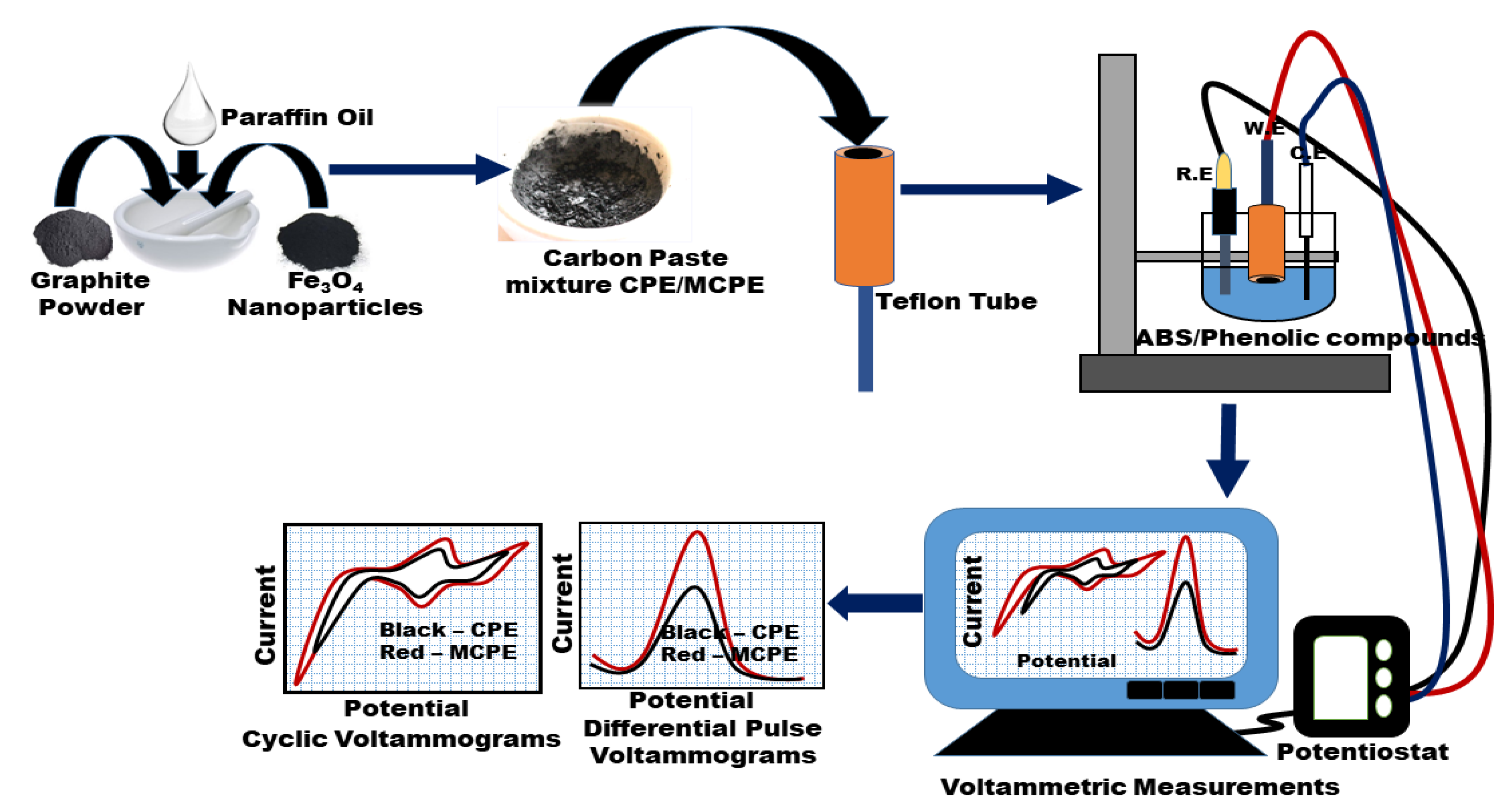
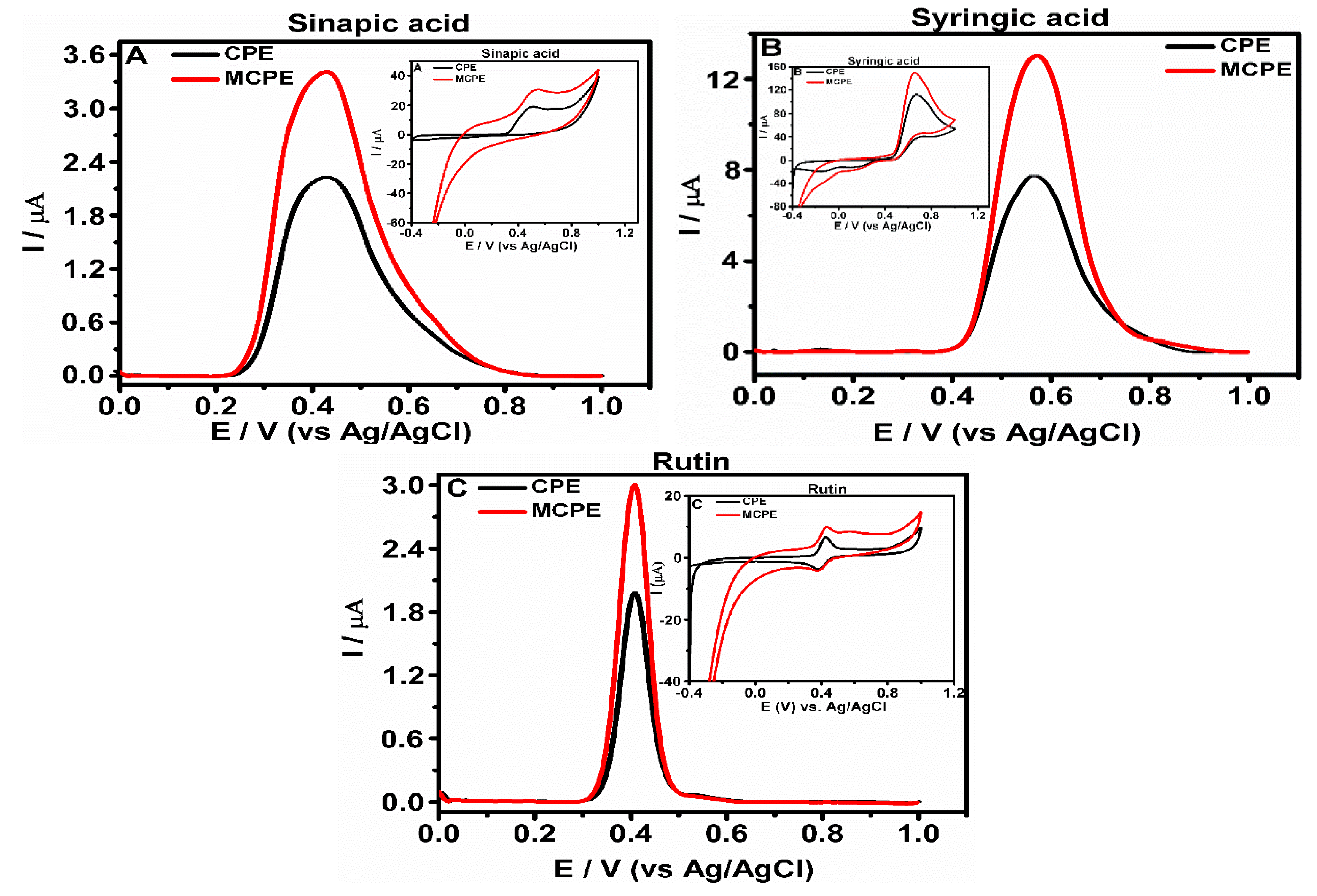
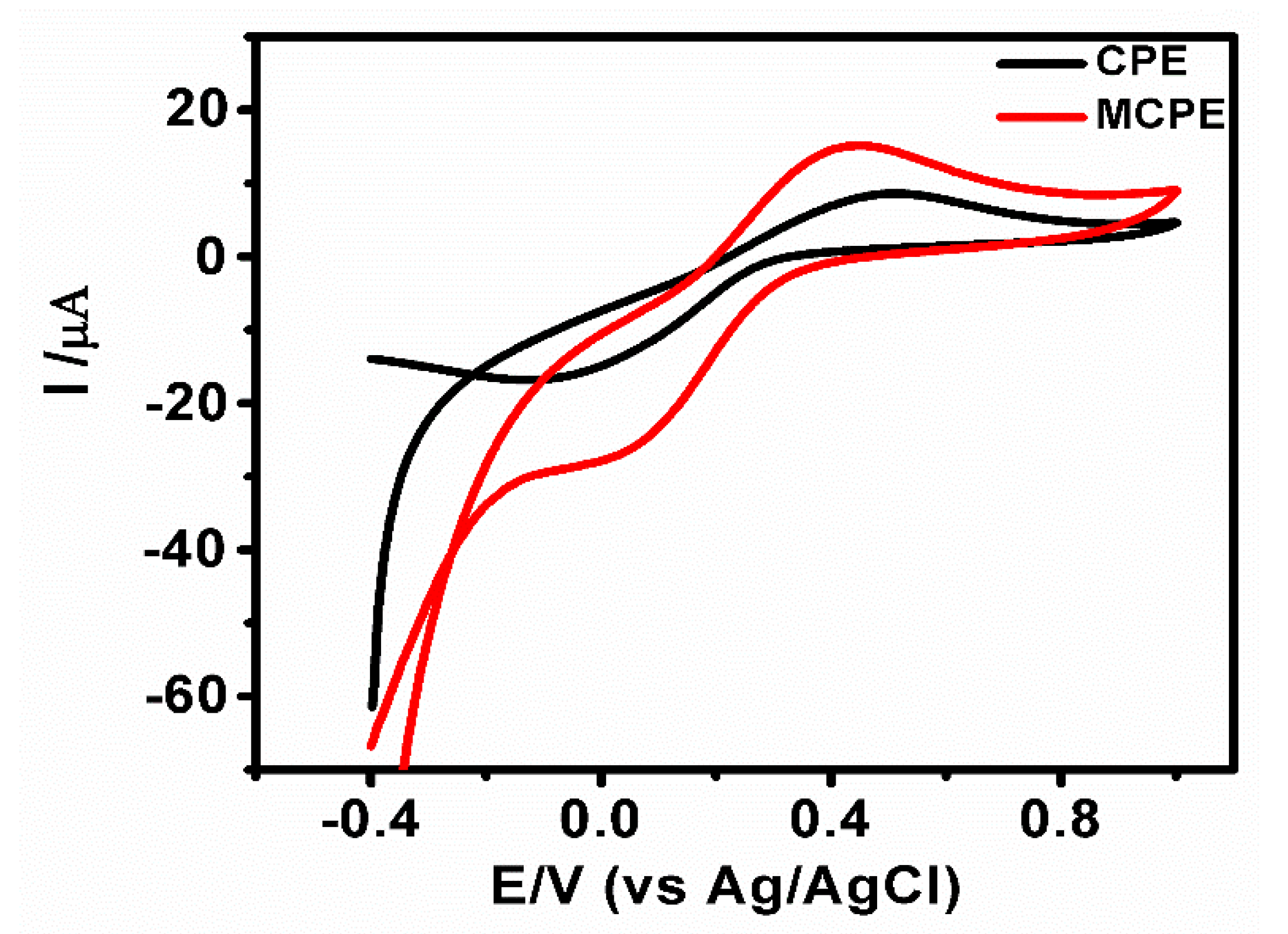
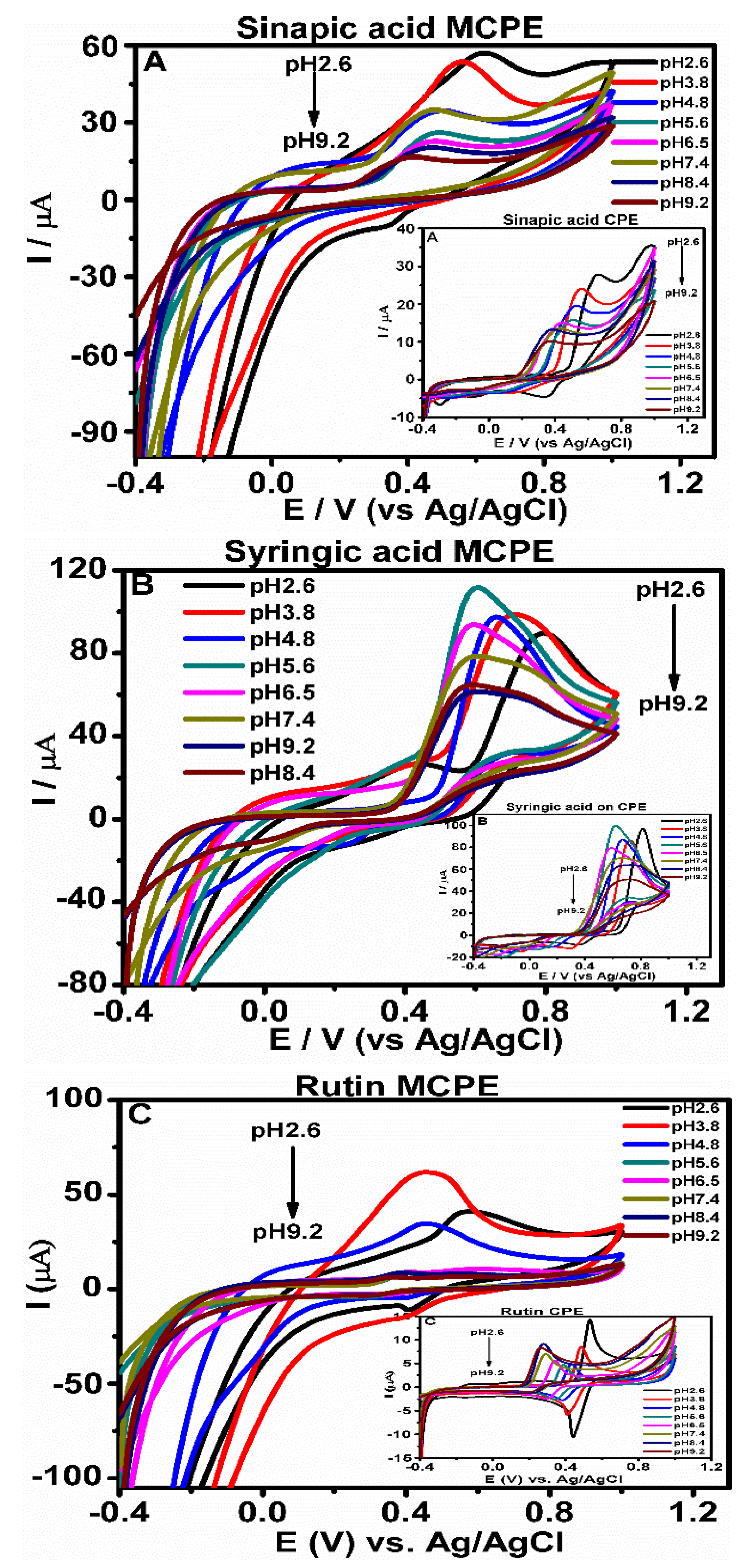
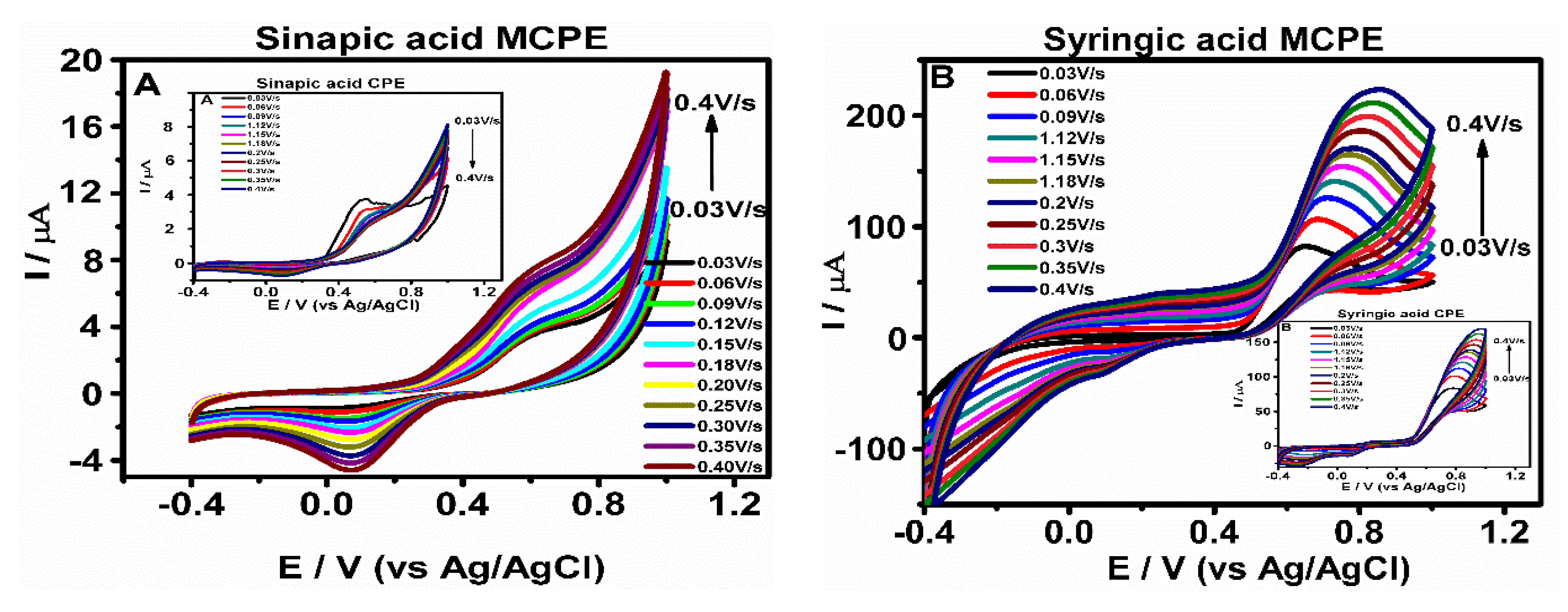
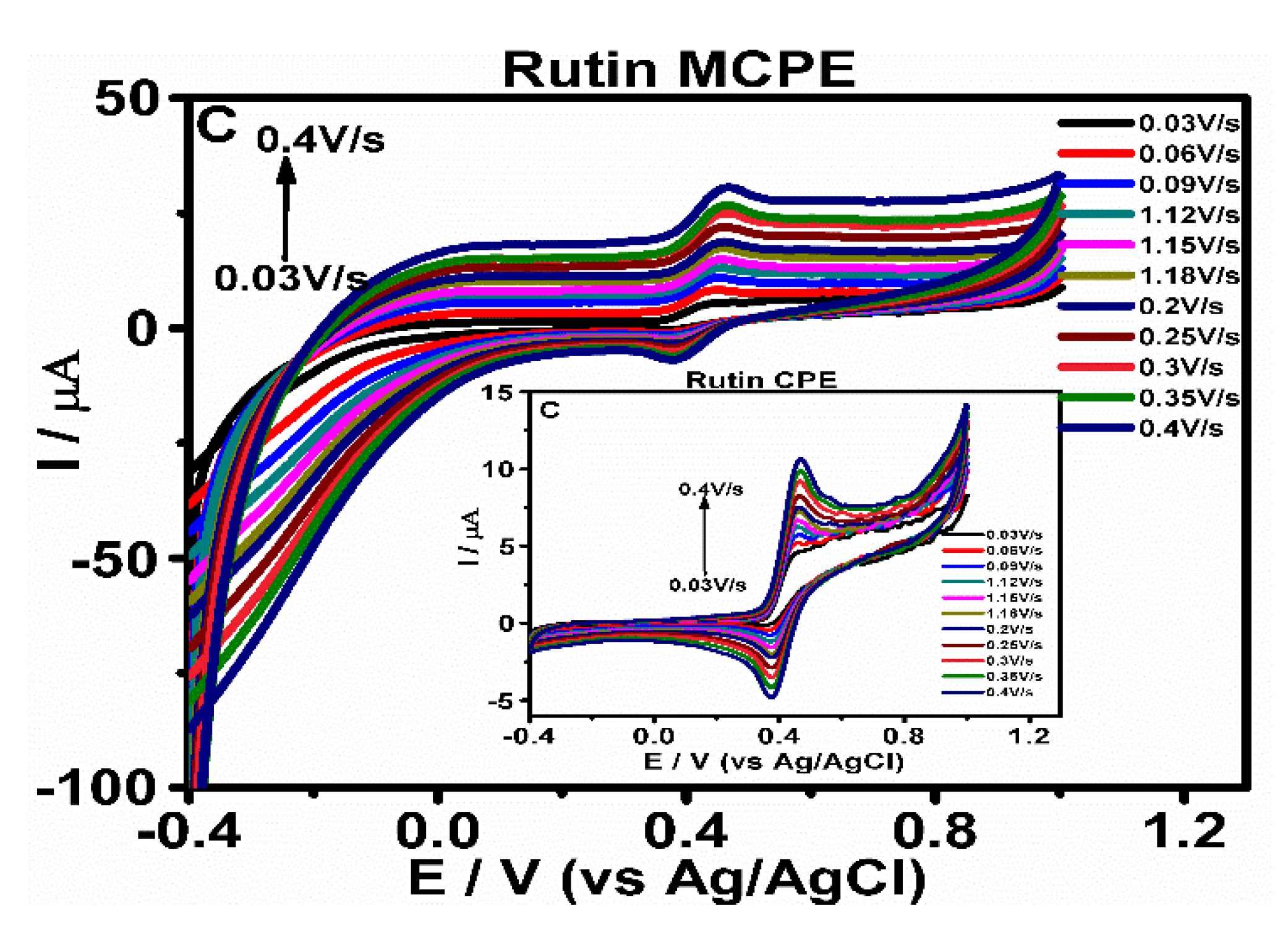
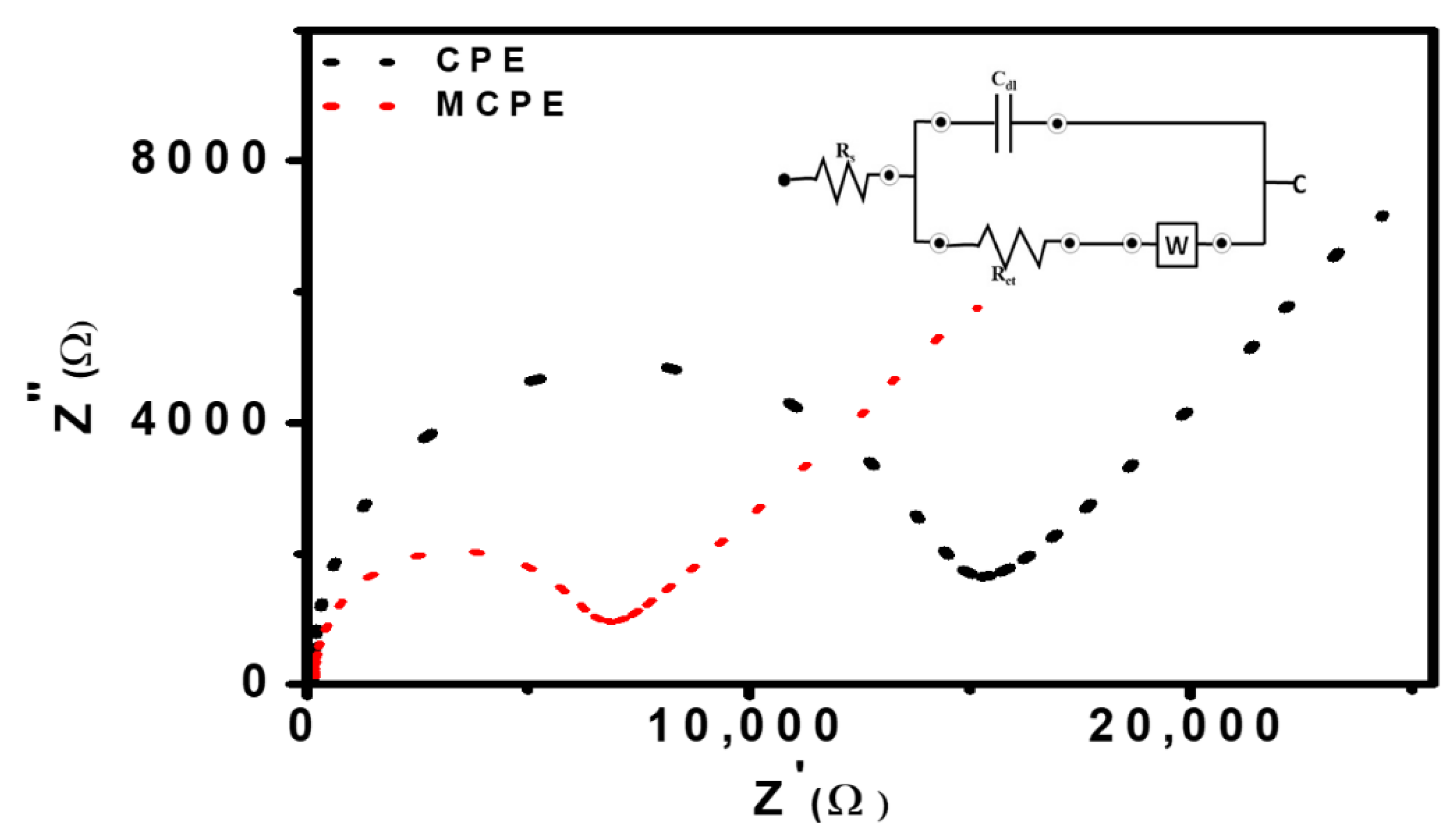
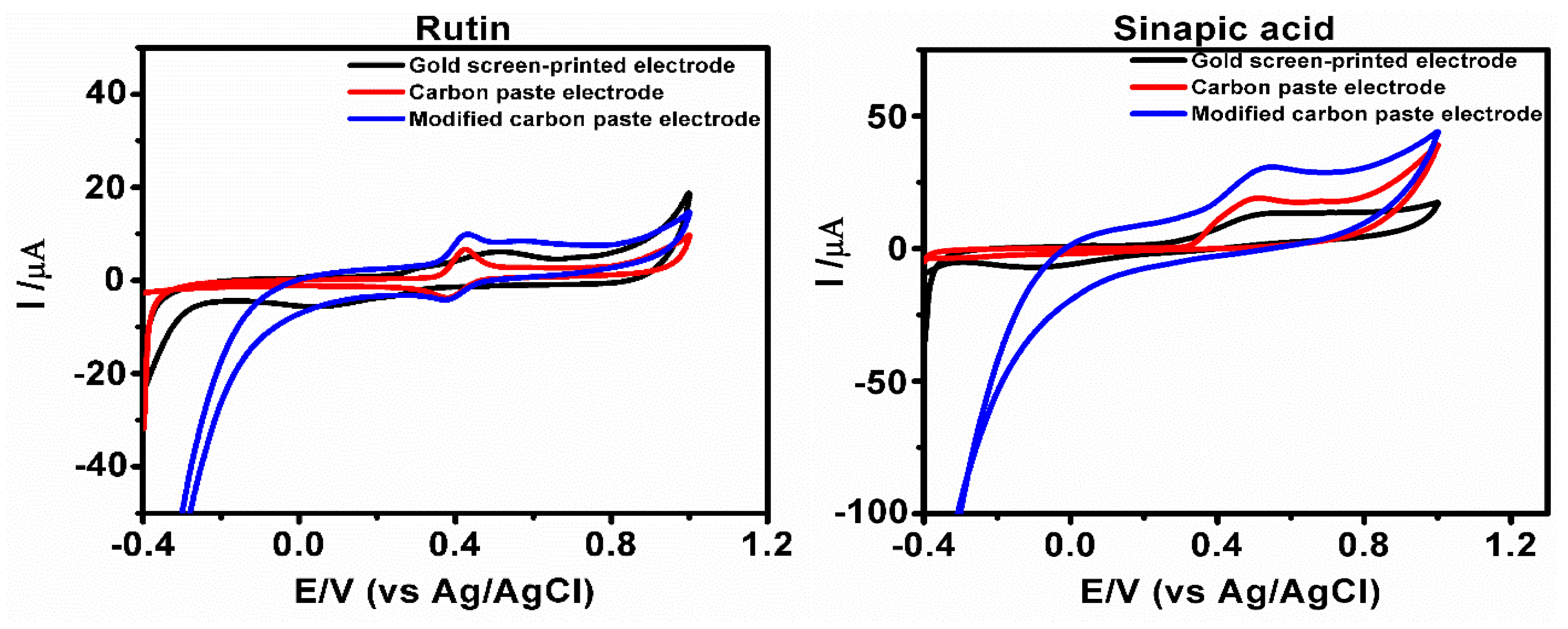
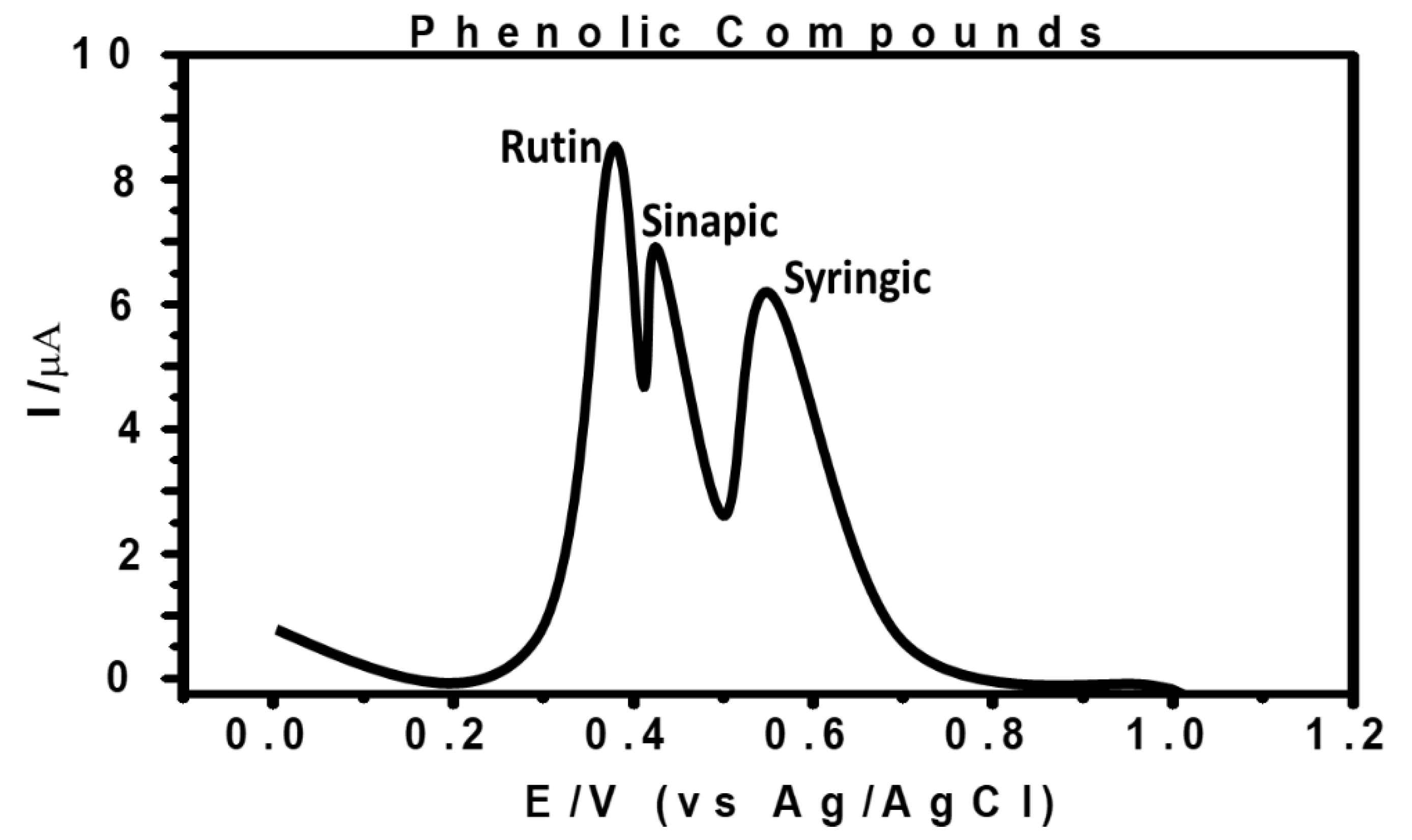
| Phenolic Compounds | Regression Equation of Anodic Peak Potentials Epa and the pH | R2 Value | Slope of Epa/pH mV/pH | Nernstian Value mV/pH |
|---|---|---|---|---|
| Sinapic acid (CPE) | Epa (V) = 0.7138–0.0398 pH | 0.9924 | 40 | 59 |
| Sinapic acid (MCPE) | Epa (V) = 0.6953–0.0338 pH | 0.996 | 34 | 59 |
| Syringic acid (CPE) | Epa (V) = 0.8883–0.0424 pH | 0.9590 | 42 | 59 |
| Syringic acid (MCPE) | Epa (V) = 1.2148–0.0366 pH | 0.9700 | 37 | 59 |
| Rutin (CPE) | Epa (V) = 0.6621–0.0486 pH | 0.9939 | 49 | 59 |
| Rutin (MCPE) | Epa (V) = 0.5787–0.0255 pH | 0.9833 | 26 | 59 |
| Phenolic Compounds | Regression Equation Ipa on ν1/2 (V/s)1/2 Controlled Diffusion | R2 Value | Regression Equation Ipa versus Scan Rate ν (V/s) Controlled Adsorption | R2 Value |
|---|---|---|---|---|
| Sinapic acid (CPE) | Ipa (μA) = 7.7340 ν1/2 − 1.5106 | 0.9545 | Ipa (µA) = 9.4885 ν − 0.1137 | 0.9988 |
| Sinapic acid MCPE) | Ipa (μA) = 17.1927 ν1/2 − 0.4542 | 0.9848 | Ipa (µA) = 20.6984 ν + 2.7275 | 0.9880 |
| Syringic acid (CPE) | Ipa (μA) = 1.8253 ν1/2 + 0.5594 | 0.9923 | Ipa (µA) = 2.1349 ν + 0.9093 | 0.9333 |
| Syringic acid (MCPE) | Ipa (μA) = 3.0278 ν1/2 + 0.3438 | 0.9977 | Ipa (µA) = 3.5624 ν + 0.9202 | 0.9510 |
| Rutin (CPE) | Ipa (μA) = 1.3556 ν1/2 − 0.1777 | 0.9805 | Ipa (µA) = 1.6414 ν + 0.4267 | 0.9964 |
| Rutin (MCPE) | Ipa (μA) = 5.5898 ν1/2 − 0.5157 | 0.9906 | Ipa (µA) = 6.7137 ν + 0.5218 | 0.9885 |
| Phenolic Compounds | Regression Equation log Ipa Versus log ν (V/s) | R2 Value |
|---|---|---|
| Sinapic acid (CPE) | Log Ipa (µA) = 0.6192 Log ν + 0.3387 | 0.9935 |
| Sinapic acid (MCPE) | Log Ipa (µA) = 0.5090 Log ν + 1.2126 | 0.9888 |
| Syringic acid (CPE) | Log Ipa (µA) = 0.49611 Log ν + 0.6904 | 0.9990 |
| Syringic acid (MCPE) | Log Ipa (µA) = 0.5119 Log ν + 0.7833 | 0.9980 |
| Rutin (CPE) | Log Ipa (µA) = 0.5168 Log ν + 0.4350 | 0.9976 |
| Rutin (MCPE) | Log Ipa (µA) = 0.6581 Log ν + 0.7490 | 0.9987 |
| Electrode | Method | Phenolic Compounds | Linear Dynamic Range(M) | Limit of Detection (M) | Limit of Quantification (M) | Ref. |
|---|---|---|---|---|---|---|
| Ni-GO/GCE | SQWV | Rutin | 1.1 × 10−8 to 1.0 × 10−6 | 3.2 × 10−9 | -- | [13] |
| CTAC/Gr/PdNPs | SQWV | Rutin | 0.02 × 10−6 to 1.0 × 10−6 | 0.005 × 10−6 | -- | [11] |
| GCE/EAuNPs/rGO/Naf | CV, LSV, EIS | Sinapic | 20 × 10−6 to 200 × 10−6 | 33.43 × 10−9 | -- | [45] |
| CPE/Fe3O4 NPs | DPV | Rutin | 0.3 × 10−6 to 3.0 × 10−6 | 0.8 × 10−7 | 2.5 × 10−7 | This work |
| CPE/Fe3O4 NPs | DPV | Sinapic | 0.9 × 10−6 to 8.0 × 10−6 | 2.2 × 10−7 | 6.7 × 10−7 | This work |
| CPE/Fe3O4 NPs | DPV | Syringic | 1.0 × 10−6 to 9.1 × 10−6 | 2.6 × 10−7 | 8.0 × 10−7 | This work |
| Interfering Species | Sinapic Acid (RSD%) | Syringic Acid (RSD%) | Rutin (RSD%) |
|---|---|---|---|
| K+ | ±4.99 | ±3.75 | ±4.03 |
| Cl− | ±1.95 | ±3.00 | ±4.78 |
| Fe+3 | ±4.27 | ±4.76 | ±3.99 |
| Ca+2 | ±4.34 | ±4.26 | ±2.20 |
| caffeic acid | ±4.85 | ±3.43 | ±4.98 |
| 4-hydroxybenzoic acid | ±3.56 | ±3.40 | ±2.74 |
| Samples Red Wine | Rutin Ip = 19.1695x + 0.0045, R2 = 0.9992 | Sinapic Acid Ip = 10.6158x + 0.1531, R2 = 0.9995 | ||||||
| Added (mmol L−1) | Found (mmol L−1) | Recovery (%) | Relative Error | Added (mmol L−1) | Found (mmol L−1) | Recovery (%) | Relative Error | |
| 0 | Undetected | - | - | 0 | 0.0002 | - | - | |
| 0.03 | 0.0294 | 98 | ±2 | 0.03 | 0.0295 | 98.33 | ±1.67 | |
| 0.05 | 0.0504 | 100.8 | ±0.8 | 0.05 | 0.0503 | 100.6 | ±0.6 | |
| Syringic acid Ip = 9.5979x + 0.198, R2 = 1 | ||||||||
| Added (mmol L−1) | Found (mmol L−1) | Recovery (%) | Relative Error | |||||
| 0 | 0 | - | - | |||||
| 0.03 | 0.03 | 100 | ±0 | |||||
| 0.05 | 0.05 | 100 | ±0 | |||||
| Samples White Wine | Rutin Ip = 26.8763x + 0.0022, R2 = 0.9999 | Sinapic acid Ip = 19.2895x + 0.00995, R2 = 0.9960 | ||||||
| Added (mmol L−1) | Found (mmol L−1) | Recovery (%) | Relative Error | Added (mmol L−1) | Found (mmol L−1) | Recovery (%) | Relative Error | |
| 0 | Undetected | - | - | 0 | Undetected | - | - | |
| 0.03 | 0.0302 | 100.67 | ±0.67 | 0.03 | 0.0313 | 104.3 | ±4.33 | |
| 0.05 | 0.0499 | 99.8 | ±0.2 | 0.05 | 0.0492 | 98.4 | ±1.6 | |
| Syringic acid Ip = 19.7829x + 0.0047, R2 = 0.9992 | ||||||||
| Added (mmol L−1) | Found (mmol L−1) | Recovery (%) | Relative Error | |||||
| 0 | Undetected | - | - | |||||
| 0.03 | 0.0306 | 102 | ±2 | |||||
| 0.05 | 0.0496 | 99.2 | ±0.8 | |||||
Publisher’s Note: MDPI stays neutral with regard to jurisdictional claims in published maps and institutional affiliations. |
© 2021 by the authors. Licensee MDPI, Basel, Switzerland. This article is an open access article distributed under the terms and conditions of the Creative Commons Attribution (CC BY) license (http://creativecommons.org/licenses/by/4.0/).
Share and Cite
Pwavodi, P.C.; Ozyurt, V.H.; Asir, S.; Ozsoz, M. Electrochemical Sensor for Determination of Various Phenolic Compounds in Wine Samples Using Fe3O4 Nanoparticles Modified Carbon Paste Electrode. Micromachines 2021, 12, 312. https://doi.org/10.3390/mi12030312
Pwavodi PC, Ozyurt VH, Asir S, Ozsoz M. Electrochemical Sensor for Determination of Various Phenolic Compounds in Wine Samples Using Fe3O4 Nanoparticles Modified Carbon Paste Electrode. Micromachines. 2021; 12(3):312. https://doi.org/10.3390/mi12030312
Chicago/Turabian StylePwavodi, Pwadubashiyi C., Vasfiye H. Ozyurt, Suleyman Asir, and Mehmet Ozsoz. 2021. "Electrochemical Sensor for Determination of Various Phenolic Compounds in Wine Samples Using Fe3O4 Nanoparticles Modified Carbon Paste Electrode" Micromachines 12, no. 3: 312. https://doi.org/10.3390/mi12030312
APA StylePwavodi, P. C., Ozyurt, V. H., Asir, S., & Ozsoz, M. (2021). Electrochemical Sensor for Determination of Various Phenolic Compounds in Wine Samples Using Fe3O4 Nanoparticles Modified Carbon Paste Electrode. Micromachines, 12(3), 312. https://doi.org/10.3390/mi12030312







